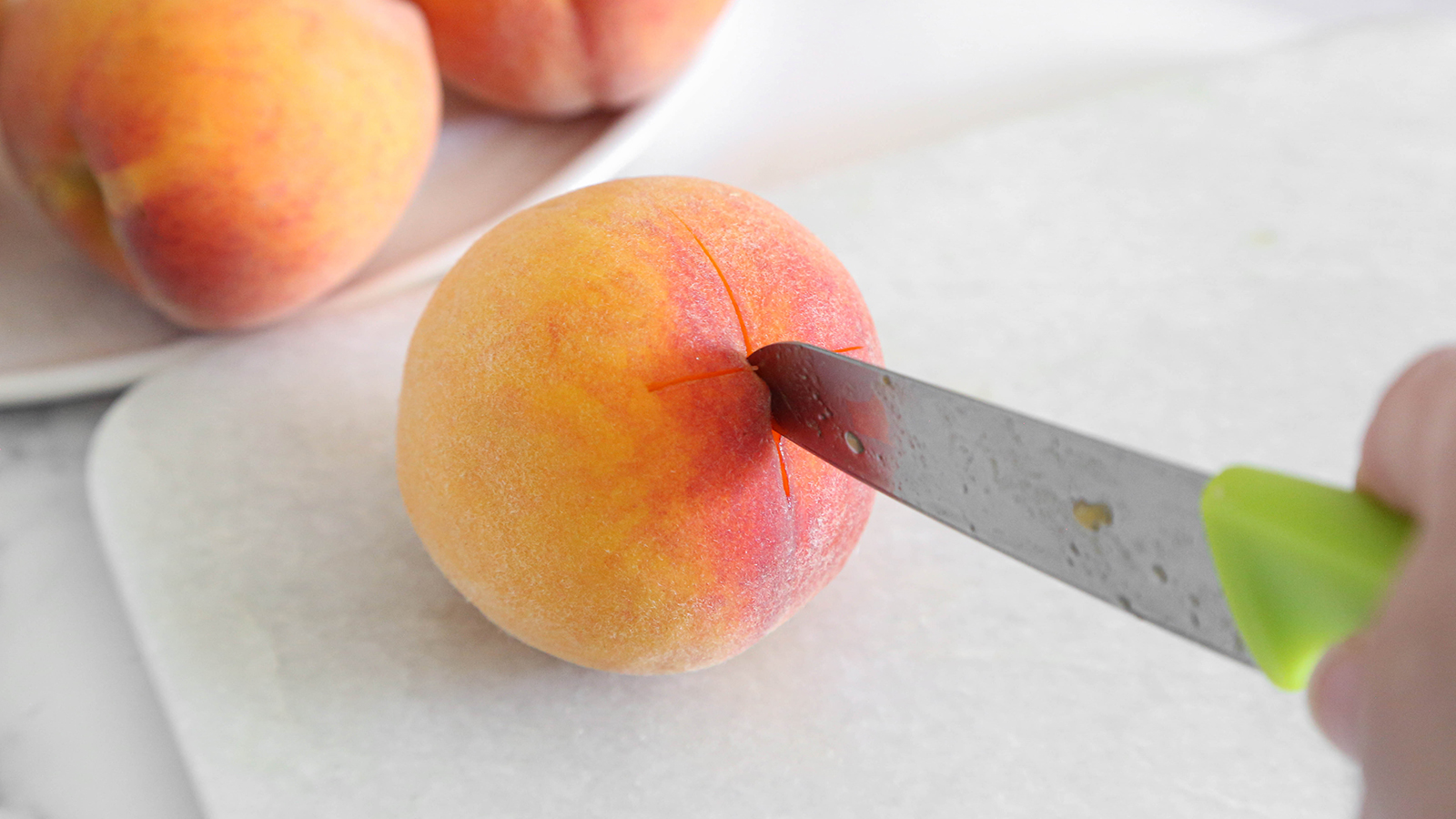How to Peel Peaches, 3 Ways
There’s more than one way to peel a peach! Here are three ways to get the job done.
By Heather Baird
There’s more than one way to peel a peach! Here are three ways to get the job done.
By Heather Baird
Cooked in a cobbler or eaten out of hand, peaches are a staple in summer’s kitchen. When preparing fresh peaches for baking in pies and crumbles, first things first; you have to peel them. While it’s perfectly safe to eat the peels (and some may argue it’s more nutritious), peeling the peaches will yield a uniform texture in your baked goods. However, figuring out how to get peaches out of their skins can be tricky. Over the course of just a few days, fresh peaches will go from taut and firm to soft and wrinkly. Whatever stage of freshness your peaches are at, we’ve got the peeling method to match it. Before you start, wash the peaches and pat them dry.
Seems like a no-brainer, doesn’t it? The vegetable peeler is great for removing the skin from under-ripe or firm-ripe peaches. Specifically, under-ripe, or firm-ripe peaches. Firm flesh and taut skin provide an ideal surface for the peeler to glide across without removing much fruit flesh. A Y-shaped peeler with a sharp blade that tilts is a great choice, as it will follow the curves of the peach as you work.
Begin at the top rounded edge of the peach. Using short strokes and light pressure, skim off pieces of peel as you work around the fruit. You should have short bits of peel falling from the peeler and onto your work surface. Don’t press too hard or you could bruise the peach. If you find that you’re having to apply too much pressure to peel the peach, your peeler may be too dull for the task. (In that case, abandon the peeler and opt for one of our other methods.) After peeling the entire peach, use the tip of a small paring knife to carve the peel away from the stem end.
Peaches that are soft and ripe require a gentler touch. A paring knife will allow you to use lighter pressure, and is perfect for peeling ripe peaches. Again, a sharp knife is important here. Mature peach skin will be tougher than young skin, and you’ll need a knife that will easily bite into the peel.
Cup a peach in your hand. Begin at the top rounded portion of the fruit and run the knife from the top edge of the peach to the bottom. Repeat until the entire peach is peeled. You may also start at the top and peel around the circumference of the peach, much like peeling an apple. If the peach is overripe, you may be able to pull the skin off as you cut. (We’ll call this the cut-and-pull method.) This may result in taking off less of the peach flesh. Use the tip of the tip of the knife to carve away any skin around the stem-end.
While it’s easy to control the pressure of a paring knife, using one usually results in losing more flesh than the other methods outlined here. It’s nearly impossible to knife-peel a ripe peach without also removing some of the flesh. That is, unless the peach is overripe, and the skins are practically peeling off already. If you find yourself with fleshy strands of peel, then save them! They’re not just for composting. (More on this later.)
The blanch-and-shock method of peeling peaches is arguably the quickest and easiest. It involves boiling the peaches in water for 30 seconds to 1 minute, then plunging them into an ice water bath. This works for most peaches that range from under-ripe to ripe. First, cut a shallow X shape into the bottom of each peach. Prepare a saucepan of boiling water on the stove top. Fill a large bowl with ice water, and have the ice water bowl close by. Keep ready to hand a slotted spoon for removing the peaches.
Lower the peaches, one-by-one, into the boiling water using the slotted spoon. Add no more than three peaches at a time so the water temperature will stay consistent. Boil ripe peaches for 30 seconds to 1 minute. You should notice that the X in the bottom of each peach will become more visible and the skin may begin to peel away. Under ripe peaches will need to boil for longer. The time depends on how under ripe they are, and you may find it necessary to boil the peaches for up to 2 minutes.
Immediately plunge the boiled peaches into the ice water. Let them swim around for a few minutes until they are cool enough to handle. Remove them to a work surface and pat them dry.
Your fingers are the best tools for peeling blanched peaches. Start at the X shape and pinch one corner of the peel and pull it back. It should slide right off without removing any of the flesh. You shouldn’t need any extra help from a paring knife to remove skins near the stem-end - they will pull right off. If the flesh doesn’t peel off easily, you need to boil the peaches longer.
Peach peels are full of flavor and highly fragrant. They can easily be made into a syrup that you can add to iced tea, pour over ice cream, or use to glaze cakes. Place peach peels in a glass jar that has a lid. Boil 1 cup of sugar with 1 cup of water on the stove top until the sugar is melted. Pour the boiling mixture over the peels and let steep, uncovered, until the syrup is cooled. Remove the peels and store in the refrigerator for up to 2 weeks.










